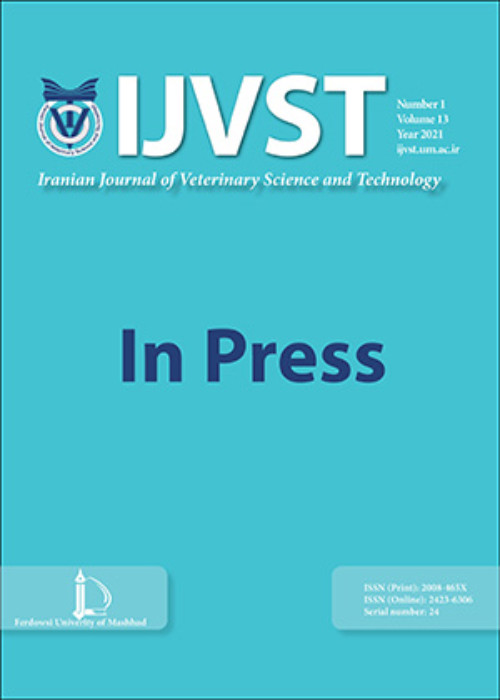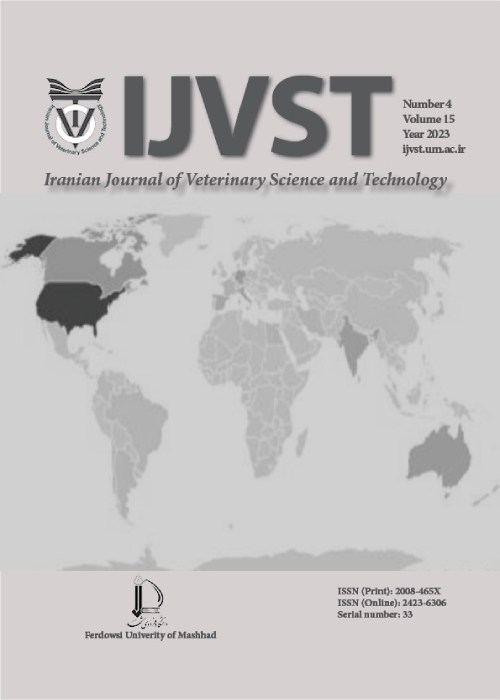فهرست مطالب

Iranian Journal of Veterinary Science and Technology
Volume:15 Issue: 2, Spring 2023
- تاریخ انتشار: 1402/04/10
- تعداد عناوین: 8
-
-
Pages 1-10
In living organisms, the central control of nutrition is a highly complex and vital mechanism. Central control of nutrition occurs in various regions of the brain, with the hypothalamus being the most important of which is the hypothalamus. The hypothalamus controls feeding behaviors through neural circuits, specialized nuclei, and central neurotransmitters. Different hypothalamic nuclei involved in regulating food intake include ARC, PVN, LHA, VMH, and DMH. The DMH influences feeding behavior by modulating the activity of different neurotransmitters in the brain. This nucleus receives both orexigenic and anorexic inputs through neural connections with the ARC and other regions of the brain. Due to its location in the brain, the ARC has access to nutritional inputs from the circulation. Within this nucleus, there exist two distinct neuronal populations, namely NPY and POMC. Different inputs from circulation affect two neuronal populations in the ARC. These inputs are related to second-order neurons, including DMH. The DMH integrates these inputs and sends the final output to PVN and LHA. Therefore, DMH affects the central control of feeding regulation through these neural pathways.
Keywords: Feeding, Hypothalamus, Dorsomedial Nucleus of Hypothalamus, brain neurotransmitters, Orexigenic, Anorexigenic -
Pages 11-18
Mycobacterium avium subspecies paratuberculosis (MAP) is the causative agent of Johne's disease in wild and domestic ruminants. Clinically, infected cattle show emaciation symptoms, diarrhea, and death. Asymptomatic subclinical cases can intermittently shed MAP through feces and milk and infect other cattle animals, thus increasing the risk of infection. The purpose of the present study was to detect the prevalence of this disease in dairy cattle. For this purpose, 348 samples were randomly collected from 15 cattle farms. All fecal samples were subjected to ZN staining and PCR of nucleotide sequences related to specific MAP gene fragments (IS900, F57) and were cultured in Harold's egg yolk culture medium after being disinfected with solution (0.0% HPC75). PCR testing of 116 fecal samples (33.3%, CI:95% 28.3-38.2), ZN staining of 23 samples (6.6%, CI: 95% 4-9.2), and fecal sample culture of only 15 samples (4.3%, CI:95% 2.3-6.3,) were infected with MAP. Comparison of test results showed poor agreement (kappa statistic: 0.19) between ZN staining and PCR results and poor agreement (kappa statistic: 0.13) between PCR test and fecal culture. This study highlights the advantages of PCR for detecting MAP in subclinically infected cattle compared to ZN staining and fecal culture. Therefore, it can be used for early detection and control of MAP in cattle and at-risk populations.
Keywords: Johne's disease, Mycobacterium avium subsp. Paratuberculosis, Ziehl-Neelsen, PCR, Iran -
Pages 19-28This study was carried out to examine the biofilm-forming ability, antimicrobial resistance, frequency of biofilm, and resistance genes, as well as the phylogenic grouping of Escherichia coli isolates originating from equine samples. In total, 157 E. coli strains were isolated from fresh feces samples of healthy horses in northern Iran. The samples were examined in terms of biofilm formation and antimicrobial susceptibility using a microtiter plate and disc-diffusion test, respectively. PCR amplification was adopted to find the genes that confer biofilm formation and resistance to β-lactam, chloramphenicol, tetracyclines, aminoglycosides, quinolones, sulfamethoxazole, and trimethoprim, and for phylogenetic analysis. More than 50% of isolates showed MDR phenotype. The most significant level of resistance was detected for streptomycin (59.87%), followed by trimethoprim-sulfamethoxazole (29.93%) and oxytetracycline (28.66%). Imipenem and norfloxacin were the most potent antibiotics. Phylogenetic groups B1 (46.50%) and A (21.66%) were the most common groups in isolates, followed by C (6.37%), clade I (5.10%), E (4.46%), D (3.82%), and B2 (2.55%). All isolates in phylogroups B2 and D carried all biofilm-related genes. In addition, antimicrobial resistance genes were common in phylogroups B2, D, A, B1, and E. These findings demonstrate that in northern Iran, healthy horses harbor potential extraintestinal pathogenic and MDR E. coli isolates. These animals can be reservoirs for antibiotics-resistant isolates. The obtained data support the current interest regarding antimicrobial resistance, MDR shedding, and managing the use of antimicrobials in veterinary science.Keywords: Equine, E. coli, Genetic diversity, Antimicrobial resistance, Biofilm
-
Pages 29-37
Cancer immunotherapy emerged as a novel therapeutic approach to destroy tumor cells, and it has grown toward clinical transition following successful fundamental research and clinical trials. Immunotherapy by efficacious adjuvants is critical for increasing protective immune responses against infectious diseases and cancers. STING and TLR9 agonists are interesting candidates for novel immunotherapies of cancers. In this study, the antitumoral effects of ADU-S100, as a potent STING agonist, and CpG ODN1826, as a TLR9 agonist, in single and combined forms in CT-26 colon adenocarcinoma model were evaluated. This model was induced in female BALB/c mice which were divided into five groups treated with PBS, ADU-S100 (20 and 40 µg), CpG ODN (40 µg), and ADU-S100 (20 µg)+CpG ODN (20 µg). The tumor volumes and weights of mice were measured every other day. On the 30th day, the tumor, spleen, and liver tissues of mice were isolated for histopathological assessment. Hematological analysis was performed on heart blood. Intratumoral injection of agonists induced significant tumor suppression in all treatment groups with profound effect in the combination group that received half concentration of single form. Moreover, the histopathological analysis of tumor tissues showed the presence of apoptotic and inflammatory cells and increased the number of lymphocytes in the blood samples of the treatment groups indicating the effective role of these agonists in clearing the tumor. Therefore, a such synergy of adjuvants may have an effective role in cancer immunotherapy and offer new perspectives on the combination of agonists that trigger innate immune sensors during malignancy.
Keywords: STING agonist, TLR9 agonist, Synergistic effect, Immunotherapy, Colon carcinoma model -
Pages 38-47This study explored the potential contribution of Orx1R within vlPAG to the learning and memory of animals with chronic migraine-like pain. Migraine was induced by repeated i.p. administration of nitroglycerin (5 mg/kg). Passive avoidance adeptness was evaluated in the shuttle box maze. The spatial memory performance was estimated using MWM tests. In the MWM task, NTG-injected rats revealed an imperative increase in escape latency and traveled the distance to catch the stage and a decrease in the time spent to pass into the goal zone in comparison to the control animals. Such NTG-evoked responses were attenuated by the post-treating intra-vlPAG injection of orexin A at 100 but not 25 and 50 pM. Furthermore, in the shuttle box test, NTG-treated rats showed eversion memory retrieval impairment as reflected by decreased phase through latency and longer time spent in the black chambers of the maze. Administration of orexin A at 50 and 100 pM could suppress NTG-related eversion memory deficiency in rats. However, orexin A (100 pM) aptitude to preserve memory performance, in both MWM and shuttle box tasks, was significantly prevented by SB334867 (20 nM) as an Orx1R antagonist. Overall, these data support the role of Orx1R within vlPAG to modulate migraine-related cognition deficits in rats.Keywords: Migraine, Nitroglycerin, Orexin A, learning, memory, Rats
-
Pages 48-55Pain is a severe symptom of many diseases, with an increasing percentage of people manifesting various types of pain. Medicinal plants provide analgesic potential with little toxicity. We performed this experiment to compare the analgesic activities of Lawsonia inermis, Waltheria indica, Moringa oleifera, and Nigella sativa in Wistar rats using writhing and paw lick responses. We grouped 21 adult female rats into seven groups (n=3), including uninduced and untreated rats (group 1), induced untreated rats (group 2), rats treated with Lawsonia inermis at 200 mg/kg (group 3), rats treated with Waltheria indica at 200 mg/kg (group 4), rats treated with Nigella sativa at 200 mg/kg (group 5), rats treated with Moringa oleifera at 200 mg/kg (group 6), and rats treated with diclofenac at 10 mg/kg (group 7). We dosed rats for 14 days after inducing the pain. Phytochemical screening showed that methanolic extracts of Lawsonia inermis, Moringa oleifera, and ethanolic extract of Waltheria indica contain: Alkaloid, saponin, steroid, tannin, flavonoid, phenols, terpene, and glycosides. The rate of weight gain in rats treated with M. oleifera and W. indica was 7%, and with diclofenac was 9% compared to the untreated control. L. inermis and N. sativa possessed a weight gain of 3% and 2%, respectively. All the extracts exhibited analgesic activities by significantly reducing the number of lick and writh in the order of Lawsonia inermis, Nigella sativa, Moringa oleifera, and Waltheria indica.This study concluded that Lawsonia inermis possess significant analgesic activities compared to other plants and the standard drug (diclofenac).Keywords: pain, Lawsonia inermis, Nigella Sativa, Moringa oleifera, Waltheria indica, Analgesic
-
Pages 56-66Considering the beneficial effects of Apium graveolens L. (Celery) on the nervous system, this study elucidates the protective effect of CEO on the experimental model of cuprizone-induced MS in male C57BL/6 mice. Frothy mice were allocated into four experimental groups: control, cuprizone (chew pellet containing 0.2 %CPZ), CEO (800 mg/kg), and CPZ+CEO. Animals received treatments based on their groups for 5 weeks. Finally, reflexive motor behavior and serum antioxidant levels were determined. Based on the findings, ambulation score, hind-limb suspension, front limb suspension, and grip strength significantly decreed in the mice treated with CPZ (p < 0.05). Hind limb foot angle, surface rights, and negative geotaxis significantly increased in the animals treated with CPZ (p < 0.05). Co-administration of CPZ+CEO significantly reduced the adverse effects of CPZ on ambulation score, surface righting, hind limb suspension, grip strength, and negative geotaxis (p < 0.05). Co-administration of CPZ+CEO significantly diminished the adverse effects of CPZ on the number of crosses in the open field test and duration on the rotarod (p < 0.05). Serum MDA activity increased while GPx, SOD, and TAS decreased in the mice treated with CPZ (p < 0.05). Co-administration of CPZ+CEO significantly reduced the adverse effects of CPZ on serum antioxidant levels (p < 0.05). These results suggested the protective effect of CEO against CPZ-induced MS mediated by its antioxidant activity.Keywords: Celery, Essential oil, Cuprizone, multiple sclerosis, Mice
-
Pages 67-72We performed this study to evaluate the effects of melatonin on oxidative stress and haematological responses following an exercise of 2000 m at maximum speed. Eighteen untrained, clinically healthy stallions of the Arabian breed with a mean body weight of 401 ± 32.11 kg (395–404 kg) and an age range of 5.7–0.54 years (5–6 years) were used in this research. The subjects were divided into three groups of six stallions each. Group I (MTEX) was treated with melatonin at a dose rate of 0.03 mg/kg orally once daily for one month. Group II (NMTX) was not administered melatonin but exercised, while the last group (OMTX) was neither administered melatonin nor exercised. The results obtained show that post-exercise, the biomarkers of oxidative stress evaluated were significantly lower (p < 0.05) in the MTEX group than in the NMTX group. The leucocyte count, neutrophil counts, and the ratio of neutrophil to lymphocyte were higher (p < 0.05) in the NMTX group than in the MTEX group. Furthermore, it was recorded that packed cell volume and the total erythrocyte count were statistically higher (p < 0.05) in the MTEX group than in the NMTX group. Therefore, we concluded that melatonin ameliorated oxidative stress and some haematological parameters will be beneficial to horses subjected to the stress of exercise.Keywords: Arabian stallion, haematological parameters, Melatonin, oxidative stress


